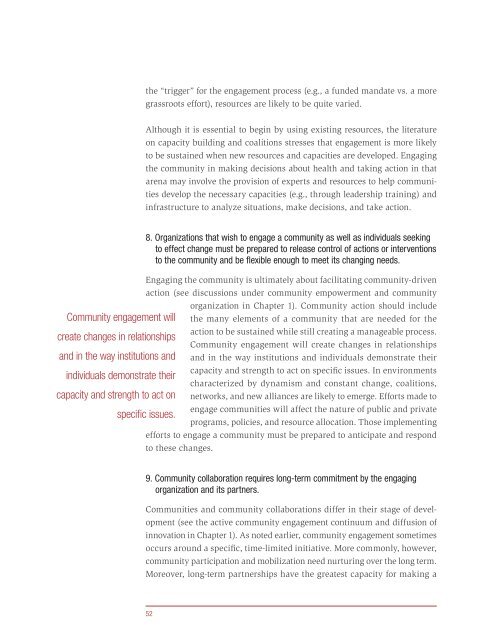Principles of Community Engagement (Second Edition)
Principles of Community Engagement (Second Edition)
Principles of Community Engagement (Second Edition)
Create successful ePaper yourself
Turn your PDF publications into a flip-book with our unique Google optimized e-Paper software.
<strong>Community</strong> engagement will<br />
create changes in relationships<br />
and in the way institutions and<br />
individuals demonstrate their<br />
capacity and strength to act on<br />
the “trigger” for the engagement process (e g , a funded mandate vs a more<br />
grassroots effort), resources are likely to be quite varied<br />
Although it is essential to begin by using existing resources, the literature<br />
on capacity building and coalitions stresses that engagement is more likely<br />
to be sustained when new resources and capacities are developed Engaging<br />
the community in making decisions about health and taking action in that<br />
arena may involve the provision <strong>of</strong> experts and resources to help communities<br />
develop the necessary capacities (e g , through leadership training) and<br />
infrastructure to analyze situations, make decisions, and take action<br />
8. Organizations that wish to engage a community as well as individuals seeking<br />
to effect change must be prepared to release control <strong>of</strong> actions or interventions<br />
to the community and be flexible enough to meet its changing needs.<br />
Engaging the community is ultimately about facilitating community-driven<br />
action (see discussions under community empowerment and community<br />
organization in Chapter 1) <strong>Community</strong> action should include<br />
the many elements <strong>of</strong> a community that are needed for the<br />
action to be sustained while still creating a manageable process<br />
<strong>Community</strong> engagement will create changes in relationships<br />
and in the way institutions and individuals demonstrate their<br />
capacity and strength to act on specific issues In environments<br />
characterized by dynamism and constant change, coalitions,<br />
networks, and new alliances are likely to emerge Efforts made to<br />
engage communities will affect the nature <strong>of</strong> public and private<br />
programs, policies, and resource allocation Those implementing<br />
efforts to engage a community must be prepared to anticipate and respond<br />
to these changes<br />
specific issues.<br />
9. <strong>Community</strong> collaboration requires long-term commitment by the engaging<br />
organization and its partners.<br />
Communities and community collaborations differ in their stage <strong>of</strong> development<br />
(see the active community engagement continuum and diffusion <strong>of</strong><br />
innovation in Chapter 1) As noted earlier, community engagement sometimes<br />
occurs around a specific, time-limited initiative More commonly, however,<br />
community participation and mobilization need nurturing over the long term<br />
Moreover, long-term partnerships have the greatest capacity for making a<br />
52

















